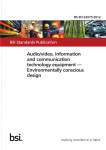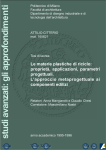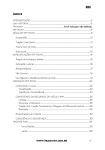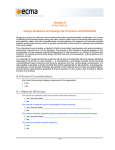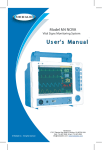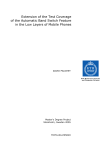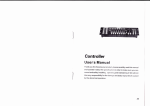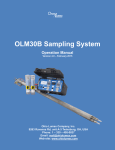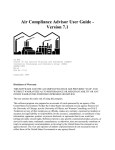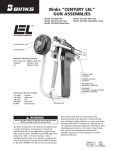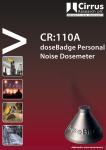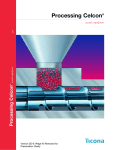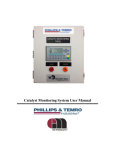Download Environmental design considerations for ICT
Transcript
ECMA-341 4th Edition / December 2010 Environmental Design Considerations for ICT & CE Products Reference number ECMA-341:2010 © Ecma International 2010 COPYRIGHT PROTECTED DOCUMENT © Ecma International 2010 Contents Page 1 Scope ...................................................................................................................................................... 1 2 Conformance ......................................................................................................................................... 1 3 Normative references ............................................................................................................................ 2 4 Terms and definitions ........................................................................................................................... 2 5 Life Cycle Thinking................................................................................................................................ 5 6 6.1 6.2 6.3 6.3.1 6.3.2 6.3.3 6.3.4 6.3.5 6.3.6 6.3.7 6.4 6.4.1 6.4.2 6.5 6.5.1 6.5.2 6.6 6.7 6.8 6.9 Design requirements and recommendations ..................................................................................... 5 General considerations......................................................................................................................... 5 Material efficiency ................................................................................................................................. 6 Energy efficiency ................................................................................................................................... 6 General ................................................................................................................................................... 6 Energy modes and related energy efficiency measures ................................................................... 6 Operational modes ................................................................................................................................ 7 Energy saving modes ........................................................................................................................... 8 Off modes ............................................................................................................................................... 9 No load mode ......................................................................................................................................... 9 General energy efficiency measures ................................................................................................... 9 Consumables and batteries ............................................................................................................... 10 Consumables ....................................................................................................................................... 10 Batteries ............................................................................................................................................... 10 Emissions ............................................................................................................................................. 11 Chemical emissions ............................................................................................................................ 11 Noise emissions .................................................................................................................................. 11 Product lifetime ................................................................................................................................... 11 End of life ............................................................................................................................................. 12 Hazardous substances and preparations ......................................................................................... 13 Product packaging .............................................................................................................................. 13 Annex A (informative) Design guidance and design for environment checklist ........................................ 15 A.1 Life cycle thinking aspects ................................................................................................................. 15 A.1.1 The organization has a management system such as an environmental management system in place covering environmental product design aspects. ............................................... 15 A.1.2 The designer has followed those policies/programs. ..................................................................... 15 A.1.3 It has been checked that any emphasis on a single stage of the life cycle of a product does not negatively alter the environmental impacts in other stages........................................... 15 A.1.4 The designer has checked with the relevant departments within the organization, which of the following aspects are considered in the environmental policy or programs of the organization: ........................................................................................................................................ 15 A.2 General considerations....................................................................................................................... 16 A.2.1 The designer has identified in cooperation with the responsible departments within the company the latest environmentally related legal and market requirements applicable to the product. .......................................................................................................................................... 16 A.2.2 The significant adverse/beneficial environmental impacts of the product during its life have been identified and analyzed in order to respectively reduce/increase them by alternative design solutions. .............................................................................................................. 16 A.2.3 Experiences from the subsequent manufacturing, sales, product usage, maintenance and disposal stages have been considered............................................................................................. 16 A.2.4 A benchmarking with the environmental performance of competitor models has been carried out. ........................................................................................................................................... 16 A.2.5 All applicable environmental product information to be made available is provided in an environmental product declaration (for example ECMA-370)......................................................... 16 © Ecma International 2010 i A.2.6 A.3 A.3.1 A.3.2 A.3.3 A.3.4 A.3.5 A.4 A.4.1 A.4.2 A.4.3 A.4.4 A.4.5 A.4.6 A.5 A.5.1 A.5.2 A.6 A.6.1 A.6.2 A.7 A.7.1 A.7.2 A.7.3 A.7.4 A.7.5 A.8 A.8.1 A.8.2 A.8.3 A.8.4 A.8.5 A.8.6 A.8.7 A.9 A.9.1 A.10 A.10.1 A.10.2 A.10.3 A.10.4 A.10.5 A.10.6 A.10.7 Certain product environmental characteristics are available. ........................................................16 Material efficiency ................................................................................................................................17 The variety of materials used in the product has been reduced. ...................................................17 The amount of material used in the product has been reduced. ....................................................17 The product contains materials that are considered to have less adverse or more beneficial environmental impact. .......................................................................................................17 The product contains recycled materials (see 6.2). .........................................................................17 The product uses renewable materials. ............................................................................................17 Energy efficiency .................................................................................................................................17 Energy modes and related energy efficiency measures. ................................................................17 Operational modes ..............................................................................................................................18 Energy saving modes ..........................................................................................................................18 Off modes .............................................................................................................................................19 No load modes .....................................................................................................................................19 General energy efficiency measures .................................................................................................19 Consumables and batteries ................................................................................................................21 Consumables .......................................................................................................................................21 Batteries................................................................................................................................................21 Emissions .............................................................................................................................................23 Chemical emissions ............................................................................................................................23 Noise Emissions ..................................................................................................................................24 Product lifetime ....................................................................................................................................25 The product contains common mechanical packages (such as covers and chassis) or common parts or components that are used for multiple models in the product family or in multiple generations of the same product. ...................................................................................25 The product contains standardised parts. ........................................................................................25 The product contains modular components. ...................................................................................25 The product contains reused components and/or parts. ................................................................25 The product contains parts targeted for reuse in maintenance and spare parts applications. .........................................................................................................................................25 End of life..............................................................................................................................................25 Separation of parts containing hazardous substances and preparations is possible.................25 Incompatible materials (including electronic modules) connected to case/housing parts or chassis are easily separable. .........................................................................................................26 The product can be disassembled down to the module level using commonly available tools. .....................................................................................................................................................26 All plastic parts weighing 25 g or more and with a flat area of 200 mm2 or more are marked with the type of polymer, copolymer, polymer blends or alloys in conformance with ISO 11469......................................................................................................................................26 The following design choices have been avoided. ..........................................................................26 The following aspects have been considered and their number and variety reduced. ...............26 The treatment information for the product includes guidance regarding the following aspects: ................................................................................................................................................26 Hazardous substances and preparations .........................................................................................27 Content in products (refer to Annex D for regulation examples) ...................................................27 Packaging .............................................................................................................................................27 The variety of packaging materials used has been reduced. .........................................................27 The amount of packaging materials used has been reduced. ........................................................27 The used packaging materials are considered to have lower environmental impact. .................28 The packaging was manufactured using recycled materials..........................................................28 The packaging was manufactured using renewable materials.......................................................28 The packaging complies with the applicable international, regional and national regulations............................................................................................................................................28 The packaging materials have an appropriate marking. .................................................................28 Annex B (informative) Bibliography ................................................................................................................29 Annex C (informative) Polymers compatibility guide ....................................................................................31 Annex D (informative) Examples of regulations ............................................................................................33 D.1 Government environmental agency URLs ........................................................................................33 ii © Ecma International 2010 D.2 D.3 D.4 D.5 D.6 Example of regulations for energy efficiency................................................................................... 34 Examples of regulations for batteries ............................................................................................... 34 Example of regulations for hazardous substances and preparations ........................................... 34 Example of regulations for end of life treatment ............................................................................. 34 Examples of regulations for product packaging .............................................................................. 34 © Ecma International 2010 iii iv © Ecma International 2010 Introduction Every product has an effect on the environment, which may occur at any or all stages of its life cycle – rawmaterial acquisition, manufacture, distribution, use, and disposal. These effects may range from low to significant; they may be short-term or long-term; and they may occur at the local, regional or global level (or a combination thereof). The interest of customers, users, developers and other stakeholders in environmental aspects and effects of products is increasing. Anticipating or identifying the environmental aspects of a product throughout its life cycle may be complex. The environmental aspects of a product have to be balanced against other factors, such as its intended use, performance, safety and health, cost, marketability, quality and regulatory requirements. It is important to consider the product functionality within the context of the system where it will be used. The process of integrating environmental aspects into product design and development has to be continuous and flexible, promoting creativity and maximizing innovation and opportunities for environmental improvement. Environmental issues should be addressed in the policies and strategies of the organization involved. Early identification and planning enable organizations to make effective decisions about environmental aspects that they control. This provides a better understanding of how their decisions will affect environmental aspects controlled by others – for example, at the raw-material and parts acquisition or end of life stages. The purpose of this document is to help designers of products in the field of audio/video, information technology and communication technology to appropriately manage related environmental issues within the design process. The vertical standard IEC 62075 is the implementation of the horizontal standard of Environmental Conscious Design as given in IEC 62430. Therefore consider this standard to be covering this accordingly. History The basic work on this sector specific environmental conscious design standard started in Ecma TC38 in 2002 where experts from a group of ICT and CE companies developed the basic concept considering engineering best practices as well as market and regulatory environmental product requirements as well as later the first edition of IEC Guide 114 (2005). The main motivation has been to develop a practical help for designers to identify the relevant aspects for an environmental conscious design. The result of that work was ECMA-341. In 2005, IEC TC108 PT62075 developed IEC 62075 based on ECMA-341 2nd edition from Ecma TC38 and drafts of the to be published horizontal standard IEC 62430. IEC published the first edition of IEC 62075 in 2008. This edition of ECMA-341 implements the recognised editorial changes identified in the 3rd edition and adds further new definitions and issues to its structure. This Ecma Standard has been adopted by the General Assembly of December 2010. © Ecma International 2010 v "DISCLAIMER This document and possible translations of it may be copied and furnished to others, and derivative works that comment on or otherwise explain it or assist in its implementation may be prepared, copied, published, and distributed, in whole or in part, without restriction of any kind, provided that the above copyright notice and this section are included on all such copies and derivative works. However, this document itself may not be modified in any way, including by removing the copyright notice or references to Ecma International, except as needed for the purpose of developing any document or deliverable produced by Ecma International (in which case the rules applied to copyrights must be followed) or as required to translate it into languages other than English. The limited permissions granted above are perpetual and will not be revoked by Ecma International or its successors or assigns. This document and the information contained herein is provided on an "AS IS" basis and ECMA INTERNATIONAL DISCLAIMS ALL WARRANTIES, EXPRESS OR IMPLIED, INCLUDING BUT NOT LIMITED TO ANY WARRANTY THAT THE USE OF THE INFORMATION HEREIN WILL NOT INFRINGE ANY OWNERSHIP RIGHTS OR ANY IMPLIED WARRANTIES OF MERCHANTABILITY OR FITNESS FOR A PARTICULAR PURPOSE." vi © Ecma International 2010 Environmental Design Considerations for ICT & CE Products 1 Scope This Standard applies to all audio/video, information and communication technology equipment marketed as final products, hereafter referred to as products. Although this Standard does not explicitly apply to individual components and subassemblies to be incorporated into final products, component manufacturers also need to consider this Standard, to enable manufacturers using such components to meet the requirements herein. Only the intended use of products as defined by the manufacturer is within the scope of this Standard. This Standard specifies requirements and recommendations for the design of environmentally sound products regarding • life cycle thinking aspects, • material efficiency, • energy efficiency, • consumables and batteries, • chemical and noise emissions, • extension of product lifetime, • end of life, • hazardous substances/preparations, and • product packaging. This Standard covers only criteria directly related to the environmental performance of the product. Criteria such as safety, ergonomics and electromagnetic compatibility (EMC) are outside the scope of this Standard and are covered by other standards. 2 Conformance Conformant applications of this Ecma Standard: - meet all of the applicable "shall" statements in Clauses 5 and 6; and - complete a design checklist for the product (or for a given family of products). © Ecma International 2010 1 3 Normative references The following referenced documents are indispensable for the application of this document. For dated references, only the edition cited applies. For undated references, the latest edition of the referenced document (including any amendments) applies. ECMA-74, Measurement of Airborne Noise Emitted by Information Technology and Telecommunications Equipment (ISO 7779) ECMA-109, Declared Noise Emission Values of Information Technology and Telecommunications Equipment (ISO 9296) ECMA-370, TED – THE ECO DECLARATION ISO 3741, Acoustics – Determination of sound power levels of noise sources using sound pressure – Precision methods for reverberation rooms ISO 3744, Acoustics – Determination of sound power levels of noise sources using sound pressure – Engineering method in an essentially free field over a reflecting plane ISO 3745, Acoustics – Determination of sound power levels of noise sources using sound pressure – Precision methods for anechoic and hemi-anechoic rooms ISO 7779, Acoustics – Measurement of airborne noise emitted by information technology and telecommunications equipment ISO 9296, Acoustics – Declared noise emission values of computer and business equipment ISO 11201, Acoustics – Noise emitted by machinery and equipment – Measurement of emission sound pressure levels at a work station and at other specified positions – Engineering method in an essentially free field over a reflecting plane ISO 11469, Plastics – Generic identification and marking of plastics products ISO/IEC 28360:2007, Information technology -- Office equipment -- Determination of chemical emission rates from electronic equipment (ECMA-328) 4 Terms and definitions For the purposes of this document, the following terms and definitions apply. 4.1 chemical emissions chemical substances and particulate matter emitted from a product into the air 4.2 consumable user-replaceable part or piece of equipment that manufacturers place on the market for direct sale for use in equipment [IEC Guide 114] NOTE Consumables include, for example, printer cartridges and photographic film, and not parts required for repairs or product upgrades. 2 © Ecma International 2010 4.3 designer persons responsible for the design and development of a product under the supervision of the manufacturer NOTE See 4.12 for context with manufacturer. 4.4 end of life life cycle stage of a product starting when it is removed from a use stage 4.5 energy efficiency and energy use rational use of energy to achieve an intended application performance More technically, it is the minimum quantity of energy required to deliver a functional output from a device. The energy used by a product from the mains power source over a given period of time is measured in kWh. NOTE A more precise definition is not applicable in this context as the output performance largely depends on the specific device. EXAMPLE For power supplies the energy efficiency is defined as the percentage of output power per input power. 4.6 environment surroundings in which an organization operates, including air, water, land, natural resources, flora, fauna, humans and their interrelation [ISO 14001:2004, definition 3.5] 4.7 environmental aspect element of an organization’s activities, products or services that can interact with the environment [ISO 14001:2004, definition 3.6] NOTE A significant environmental aspect is one that has or can have a significant environmental impact (ISO 14001:2004, definition 3.7). 4.8 environmental impact any change to the environment whether adverse or beneficial, wholly or partially resulting from an organization’s environmental aspects [ISO 14001:2004, definition 3.7] 4.9 environmental management system part of the overall management system that includes organizational structure, planning activities, responsibilities, practices, procedure, processes, and resources for developing, implementing, achieving, reviewing and maintaining the environmental policy [ISO 14001:2004, definition 3.8, modified] 4.10 hazardous substances and preparations substance or preparation that can adversely impact the environment with immediate or retarded effect [IEC Guide 109:2003, definition 3.6, modified] © Ecma International 2010 3 4.11 life cycle consecutive and interlinked stages of a product, from raw material acquisition or generation of natural resources to the final disposal [ISO 14040:2006, definition 3.1] 4.12 manufacturer organization responsible for the design, development and manufacture of a product in view of its being placed on the market, regardless of whether these operations are carried out by that organization itself or on its behalf 4.13 module assembly of parts of a product with a function in itself (for example, a power supply) including those separately put on the market as a product 4.14 organization company, corporation, firm, enterprise, authority or institution, or part or combination thereof, whether incorporated or not, public or private, that has its own functions and administration [ISO 9001:2008, definition 3.16] 4.15 part any piece or object of, or included with, a product 4.16 preparations mixtures or solutions composed of two or more substances EXAMPLE Tin is a substance and solder is a preparation (an alloy) that may contain tin. 4.17 product audio/video, information and communication technology equipment 4.18 recycling reprocessing of products, modules or parts thereof for reuse or other purposes during their end of life stage 4.19 renewable material organic material not based upon fossil carbon sources 4.20 reuse recycling of products, modules or parts by entering in a subsequent product use stage 4.21 skilled person person with relevant education or experience to enable him or her to avoid dangers and to reduce the likelihood of risks that may be created by the equipment [IEV 826-18-01, modified] 4 © Ecma International 2010 4.22 substance matter with an individual molecular identity 4.23 upgrading process to enhance the functionality or capacity of a product 4.24 use stage period of the product’s life from placing it into service until it enters its end of life stage 5 Life Cycle Thinking Environmentally conscious design (ECD) shall be based on the concept of life cycle thinking (LCT), which requires consideration during the design and development process of the significant environmental aspects of a product in all life cycle stages. Key elements of life cycle thinking are: a) having an objective to minimize the overall adverse environmental impact of the product; b) identifying, qualifying and where feasible, quantifying the significant environmental aspects of the product; c) considering the trade-offs between environmental aspects and life cycle stages. The above shall be initiated as early as possible in the design and development process, when most opportunities exist to make changes and improvements to the product affecting its overall environmental performance throughout its life cycle. NOTE 1 As a first step in LCT, the intended function of the product should be determined. In subsequent design and development stages the influence of any applied business model should be recognized. NOTE 2 The life cycle stages of any product under control of the organization usually include the processing of materials, manufacturing, distribution, use, maintenance, and end of life management (including reuse, recycling, recovery and final disposal). NOTE 3 When a product is part of a system, the environmental performance of one product during one or more life cycle stages can be altered by other products in that system. NOTE 4 6 6.1 ECD requires collaboration and contributions of all stakeholders along the supply chain. Design requirements and recommendations General considerations The following requirements have been compiled for use when designing and developing products as defined in the scope of this Standard, as far as they can be practically influenced by the designer. The designer • shall identify the latest environmental related legal and market requirements (from customers, government, environmental groups, industrial associations, etc.); • should do benchmarking addressing the comparison of energy efficiency, material efficiency, and the use of hazardous substances or preparations; © Ecma International 2010 5 • should gather and evaluate experience from the subsequent manufacturing, sales, product usage, maintenance and disposal stages, to continually improve the process of environmentally conscious product design. The entire environmental performance of the product should be evaluated, while the considerations should give priority to those factors that can be substantially influenced through product design and are identified as major environmental impacts (for example, very often energy consumption). The evaluation should take into consideration the functions and normal usage of the product as well as the technical and economical feasibility. As a minimum, the designer shall document decisions by some means, such as by maintaining a design checklist covering environmental aspects (an example for such a checklist is provided in Annex A). This Standard requires certain product environmental characteristics to be made available in a form the manufacturer deems appropriate. Further applicable information may be made available in an environmental product declaration (for example, ECMA-370). 6.2 Material efficiency Material selection has an impact on the environment. When specifying materials, the designer should consider design alternatives that: • reduce the variety of materials used; • reduce the amount of material used and consequently the weight of the product; • use materials that are considered to have lower adverse environmental impact; • seek to use materials that can be easily recycled. Material-related end of life aspects are covered in 6.7. For replacing materials containing hazardous substances and preparations, see 6.8. 6.3 6.3.1 Energy efficiency General To focus efforts on increasing energy efficiency, the designer shall be aware in which stage of the product life cycle the product will consume the most energy. The intended use patterns of the product, including where relevant its typical system interactions, shall be considered. Where possible, the organization should strive for improving the overall system performance in respect to energy efficiency. Energy consumption information shall be made available (see 6.3.5d and 6.3.7). Terms and definitions will be aligned with the upcoming new horizontal standard IEC 62542 once they are finalized. Beyond that the standard EN 62301-1 has been developed to address the requirements for low power measurements of electrical and electronic equipment. 6.3.2 Energy modes and related energy efficiency measures Energy mode definitions and applied terms vary depending on the product group. Therefore, rather than providing precise definitions of energy modes in this Standard, modes are described in generic terms as 6 © Ecma International 2010 defined in 6.3.3 – 6.3.6 and illustrated in Figure 1. The intent is to balance the technical complexity with the simplicity needed for ease of communication and use. NOTE Due to the high diversity of products covered by this Standard, examples are intended to clarify the energy modes and to guide the designer. The designer shall identify specific energy modes that apply to the product under development. The designer shall consider energy efficiency measures for the identified energy modes (described in more detail in the following sections). Designers shall also identify where energy is consumed with the product and take steps to reduce the overall energy consumption. Energy Modes Operational Modes Energy Saving Modes Off Modes On-Maximum Soft-Off On-Normal Hard-off No Load Mode On-Idle Figure 1 — Energy mode classification 6.3.3 Operational modes Products perform their intended functions in the on-maximum, on-normal and on-idle operational modes. − On-maximum: Operation with all options in use. EXAMPLE 1 A television with maximum contrast, brightness and sound, or a personal computer with all slots and bays populated and operating. − On-normal: Operation with default/standard configuration. EXAMPLE 2 The factory setting of a computer display or a printer in active/run mode. © Ecma International 2010 7 − On-idle: Operation with minimum system load by user and ready to operate without delay. EXAMPLE 3 A personal computer running with no user initiated task consuming significant computing resources, or a printer in ready mode. The designer shall consider: − using low power components and/or design options as well as efficient power supply components to reduce the energy consumption in the on modes. NOTE 1 The reason for the above is that less efficient designs result in higher heat dissipation in the system, which leads to increased cooling requirements. By improving the energy efficiency of these designs in the on-mode, it may become possible to apply passive cooling thereby avoiding the use of fans and the resulting additional energy consumption. NOTE 2 − Energy efficiency improvements typically reduce costs and noise and improve serviceability. identified modes (see 6.3.2) when specifying the power supply. The AC-DC conversion efficiency should be high in the most used modes, for example, by applying voluntary programs and agreements as described in 6.3.7. EXAMPLE 4 For typical personal computers in office use, the on-idle mode might represent a substantial percentage of the on-mode consumption and thus the conversion efficiency for this mode should be high. However, in many personal computers, the power supply loading is low in the on-idle mode, and hence often the conversion efficiency is low. NOTE 3 Another reason for a low loading and therefore reduced power supply efficiency is the inherent extendibility of a system such as a personal computer. As such, the designer should balance extendibility vs. energy consumption. − the true specification needs for the product. For example, over specifying the rating of the power supply can lead to an energy inefficient design. − the effect of the operating environment specification provided to users and installers. For example, over specifying the maximum allowed ambient (room) operating temperature for large telecom, server or storage units can lead to energy inefficiencies in the room cooling systems. 6.3.4 Energy saving modes Energy saving modes, often denoted as low power, sleep, deep sleep or stand-by, are states in which the equipment is connected to an electrical supply and is ready to resume an operational mode, within a user acceptable timeframe, through the use of remote control or another signal. In complex systems, various energy save modes may be present. EXAMPLE 1 Sleep [stand-by/suspend to RAM (random access memory) mode for computers], stand-by-active high mode (set-top-box exchanging data with an external source but not providing picture or sound to the television), stand-byactive low mode (DVD-recorder programmed for recording but not recording/providing picture or sound to the television), stand-by-passive (television not providing picture or sound, but can be switched into operational mode by the remote control). The designer shall: − consider practical design options to automatically switch from on mode to energy save modes. The energy save mode settings should be adjustable by the user and designed in a way that it is likely to be adjusted if necessary to an alternative or custom setting, more suitable to their typical use. Other innovative solutions shall be considered; EXAMPLE 2 A computer monitor may activate sleep mode when the user is detected to have left the viewing area or after a specified period of inactivity of manual input devices such as keyboard and mouse. − 8 consider the effect of the time to resume on the user acceptance to use the energy save modes; © Ecma International 2010 EXAMPLE 3 The delay time for the first copy/print to start from energy save mode on a copier/printer. − consider design options to reduce the energy consumption in the energy save modes by also applying similar methods as described in 6.3.3; − inform the user of the higher energy consumption if the energy save mode is disabled. 6.3.5 Off modes While connected to an electrical supply, products consume the least power in the following off modes: − Soft-off: The equipment is switched off by the device itself or initiated by the user via remote control or command. EXAMPLE 1 − Printer in auto-off mode or computer after shutdown was completed. Hard-off: The off-power state in which the device uses zero watt (minimum energy consumption might occur due to line filters). The equipment is manually switched off with the main power switch [see c] and d) below]. EXAMPLE 2 Monitors, televisions and laser printers switched off at the primary side of the power supply and thus consuming no energy. The designer shall a) consider design options to automatically switch from energy save mode to an off mode where practical, b) consider design options to reduce the energy consumption in the soft off modes to lowest values (minimum energy consumption might occur due to line filters), c) consider a main power switch. If applicable, the main power switch should be placed on the product such that the user can easily reach and use it, d) prepare energy consumption data (energy level in watthours) for a state a user would consider hard off but for which a power level of zero watt is not achievable and inform the user through documentation or other means. 6.3.6 No load mode No load mode is the mode in which external power supplies or chargers are connected to an electrical supply, but are not connected to electrical or electronic equipment for which they have been designed. EXAMPLE A mobile phone charger is plugged in, but the phone is not connected. The designer shall consider design options that reduce energy consumption of no load mode to the lowest value. 6.3.7 General energy efficiency measures All available energy saving features shall be documented during the design process. Information on the product’s energy consumption and, where applicable, its related energy modes shall be made available to the user. Designers shall consider the requirements of international programmes, applicable for the product category, aimed to increase energy efficiency. © Ecma International 2010 9 EXAMPLE 1 The Energy Star international programme has made a number of product specifications and memoranda of understanding, available here: http://www.energystar.gov. Designers should consider other agreements as applicable aimed to improve energy efficiency. The effects of the improved design decisions compared to previous similar designs should be quantified and communicated to product marketing departments in order to enable them to promote products with lower adverse total environmental impact through lower energy consumption. The designer should enable the most energy efficient on modes and transitions to energy saving mode as the default modes with performance taken into consideration after transitions to energy saving modes as the default mode. If this is not reasonably achievable, the user shall be made aware of this and instructions on proper use of available energy saving controls and/or settings shall be provided to users. Instructions may be included in product user documentation in either printed or electronic form. EXAMPLE 2 A user should be made aware that enabling the wake-up on Local Area Network features prevents the product from entering the soft-off energy saving mode. If the product applies software and/or firmware, the designer shall be aware of the relevance of those for the overall energy efficiency of a system. The designer should balance the flexibility of software running on multipurpose devices and the energy efficiency of special purpose hardware. 6.4 Consumables and batteries 6.4.1 Consumables For consumables, designers shall also consider the guidance specified in 6.7. Products should be designed such that the use of consumables can be optimized relative to the functionality of the product. Designers should consider: − functions to reduce or save the use of consumables; − ease of replacement and maintenance of consumables. The manufacturer shall provide users with information on the proper use of consumables relative to the functionality of the product and, where appropriate, end of life management of the consumables. 6.4.2 Batteries Batteries shall comply with all applicable restrictions such as on hazardous substances and preparations (see 6.8), design requirements on equipment containing batteries and, to the extent possible, all international labelling requirements. Batteries with reduced environmental impact shall be considered. When materials with adverse environmental impact cannot be avoided (for example, mercury in button cells), the material and its justification shall be documented during the design process. Batteries shall be easily identifiable and removable, either by users or skilled persons, except where the battery life span exceeds that of the product. In case the life span of the battery exceeds that of a product, batteries shall be removable for end of life treatment. Product documentation shall give advice for the safe removal of the battery by either users or skilled persons. Information on batteries in the product shall be made available. This information shall include details on the types of the batteries and their locations, as well as proper procedures for safe removal and handling of the batteries, including information on end of life management/proper battery disposal. Designs that prolong the durability of batteries shall be considered. 10 © Ecma International 2010 6.5 Emissions 6.5.1 Chemical emissions Products shall be designed such that chemical emissions with adverse environmental impact during use are reduced wherever possible. For products that use an electrostatic process, emission rates determined according to ISO/IEC 28360 should be made available. 6.5.2 Noise emissions The designer shall consider techniques to reduce noise emissions. NOTE Reduced noise emissions improve energy efficiency. In particular, noise emissions shall be evaluated according to ISO 7779, for products covered by ISO 7779 (or ECMA-74). For products under the scope of this Standard and not covered by a product specific international standard noise test code, such as ISO 7779 (or ECMA-74), noise emissions do not have to be evaluated. If noise emissions are evaluated for products under the scope of this Standard but not covered by either ISO 7779/ECMA-74 or another product-specific international standard noise test code, the basic sound power standards, ISO 3741, ISO 3744 or ISO 3745, and the basic emission sound pressure standard, ISO 11201, shall be used. The test conditions used should be recorded. The resulting sound power levels and, where applicable, emitted sound pressure levels (including emission sound pressure measurement distance if not covered by ISO 7779/ECMA-74) shall be declared according to ISO 9296 (or ECMA-109) and should be documented according to available eco-declaration standards (such as ECMA-370). The levels shall be made available in the product information. NOTE 1 The additional noise from cooling systems is a frequent issue for audio and video systems and computers in home or silent office environments. NOTE 2 The declared A-weighted sound power level LWAd, according to ISO 9296, is a statistical maximum value to account for product variation and lab-to-lab variations, and LWAd is typically about 0,3 bels – 0,4 bels (3 dB – 4 dB) greater than the arithmetic average of A-weighted sound power level LWA, measured according to ISO 7779, ISO 3741, ISO 3744 or ISO 3745. ISO 9296 (or ECMA-109) specifies how to determine and verify LWAd. 6.6 Product lifetime Where technically and economically feasible, products shall be designed to have a prolonged useful life and be easy to upgrade and repair. However, designers shall consider the balanced compromise of using up to date and efficient technology and prolonging the life of inefficient products. Designers shall consider incorporating the following features: − use of common mechanical packages (such as covers and chassis) or common parts or components that are used for multiple models in the product family or in multiple generations of the same product, allowing for the reuse of common parts; − use of standardised parts that may be more easily replaced or repaired; − use of modules; − reuse of modules, parts and products, whenever applicable. Parts, which may be targeted for reuse (for example, in maintenance and spare parts applications) should be identified. © Ecma International 2010 11 To encourage the optimisation of a product’s useful life, information on available options for upgrading, expanding and repair of products shall be made available if appropriate. NOTE 1 Specifics on design for upgradeability may need to be identified based on product categories, and/or initial cost of a product. There are categories of products for which upgradeability features may not be applicable, for example, single use cameras and pocket calculators. NOTE 2 6.7 Some of the guidelines provided in this subclause will aid serviceability. End of life Product design shall facilitate reuse, recycling and proper disposal at end of life. The following design principles, where appropriate for the expected end of life processes, shall be applied: − easy and safe separation of parts containing hazardous substances and preparations shall be possible (see 6.8); − materials (including electronic modules) connected to case/housing parts or chassis intended for different end of life treatment shall be easily separable; − disassembly down to the module level (for example, power supply, disk drive, circuit board) shall be possible using commonly available tools and all such modules shall be easily accessible; − mark type of polymer, copolymer, polymer blends or alloys of plastic parts, including additives weighing 25 g or more and with a flat area of 200 mm 2 or more, in conformance with ISO 11469. NOTE 1 Safety and performance considerations may override some of the requirements mentioned above. NOTE 2 There are categories of products for which dismantling may not be practical at end of life. Considering the expected end of life processing, designers should: − Limit the number of polymers used in the product. Combinations of non-compatible materials which are not readily separated from each other shall be avoided, since this can compromise effective recycling. The compatibility guideline in Annex B should be used in selecting polymers when combinations of materials are intended to be used which could not easily be separated from each other. Advice on whether particular combinations of materials are readily compatible for the purposes of recycling can be obtained from polymer suppliers, specialized plastics recyclers or manufacturers who compound plastics; − use labels and other identification marks made from the same material as the body of the products or a compatible material, where possible; NOTE There may be specific, for example safety requirements for labels. − design for ease of disassembly; − avoid the use of: 12 non-recyclable composites; coatings and surface finishes on plastic parts; adhesive backed stickers or foams on plastic parts; if stickers are required, they should be separable; metal inserts in plastic parts (unless easily removable with common tools); © Ecma International 2010 − reduce the number and variety of: welds and glued joints; connections (for example, fasteners and screws); steps necessary to remove targeted substances, preparations or parts in a treatment process; tools required for disassembly or extraction; position changes that have to be made by the dismantler. Designers shall be aware of product end of life regulations to ensure legal compliance for products sold in targeted countries. Designers should prepare end of life treatment information that includes: − identification of potentially valuable and/or re-usable parts; − identification of parts containing hazardous substances and preparations and the location of such parts; − special handling and disposal precautions. 6.8 Hazardous substances and preparations Reducing and/or eliminating hazardous substances and preparations shall be considered as one of the priorities in the design of products. Designers shall be aware of (international, regional and national) prohibitions on the use of hazardous substances and preparations to ensure legal compliance for products sold in targeted countries. Consult Annex C for a list of examples of such regulations. Designers shall attempt to reduce the use of substances that require special handling or disposal during the product recycling process. Appropriate information on parts requiring special handling or disposal shall be made available to product users and recyclers. When hazardous substances and preparations other than those that are restricted cannot be avoided, they shall be identified and an indication as to why they cannot be avoided shall be recorded during the design process. Of special interest is the emerging chemical legislation in the target countries. There is a worldwide move to update and harmonise requirements on substance use (see Annex D.4). 6.9 Product packaging Packaging material selection and its design has an impact on the environment. When specifying materials and designing packaging, the designer should consider design alternatives that: − reduce the amount of material used and consequently the weight and size of the package; − use materials that are considered to have lower adverse environmental impact; − use recycled materials; − use renewable/recyclable (considering available recycling technologies) materials. © Ecma International 2010 13 As a minimum requirement the designer shall ensure compliance to international, regional and national regulations, concerning: − restrictions on hazardous substances and preparations; − recyclability, such as reuse or recycling; − appropriate marking (material content) of packaging materials. 14 © Ecma International 2010 Annex A (informative) Design guidance and design for environment checklist The design checklist is intended solely for use of the designer. It is not intended to document environmental features for end users or to be used by end users to compare products. This annex provides guidance in the form of an example checklist, that may be used to evaluate and record the requirements and recommendations according to this Standard during the design and/or redesign process. This is a generic checklist and not every item on the checklist is applicable to every product and/or product group. It is recognised that there is a wide range of products covered under the scope of this Standard. For this reason it is not possible to provide a unique checklist for every type of product or family (group) of products. Designers should generate a design checklist based on the design requirements of this Standard and through other reference material and technical reports that will accurately reflect their specific product or family of products. A.1 Life cycle thinking aspects A.1.1 The organization has a management system such as an environmental management system in place covering environmental product design aspects. ( ) ISO 14001 ( ) Other, please list: ( ) No A.1.2 The designer has followed those policies/programs. ( ) Yes ( ) No A.1.3 It has been checked that any emphasis on a single stage of the life cycle of a product does not negatively alter the environmental impacts in other stages. ( ) Yes, describe briefly ( ) No – Please explain why: A.1.4 The designer has checked with the relevant departments within the organization, which of the following aspects are considered in the environmental policy or programs of the organization: ( ) Extraction/processing of raw materials ( ) Procurement ( ) Manufacturing ( ) Transportation/distribution ( ) Product design ( ) Packaging © Ecma International 2010 15 ( ) Use ( ) Recycling, reuse and final disposal A.2 General considerations A.2.1 The designer has identified in cooperation with the responsible departments within the company the latest environmentally related legal and market requirements applicable to the product. ( ) Yes ( ) No A.2.2 The significant adverse/beneficial environmental impacts of the product during its life have been identified and analyzed in order to respectively reduce/increase them by alternative design solutions. ( ) Yes, describe briefly ( ) No A.2.3 Experiences from the subsequent manufacturing, sales, product usage, maintenance and disposal stages have been considered. ( ) Yes ( ) No A.2.4 A benchmarking with the environmental performance of competitor models has been carried out. ( ) Yes ( ) No A.2.5 All applicable environmental product information to be made available is provided in an environmental product declaration (for example ECMA-370). ( ) Yes ( ) No A.2.6 Certain product environmental characteristics are available. ( ) Yes, list sources [ ] Product specification document [ ] Manufacturer environmental product declaration [ ] Product user manual (hard copy) [ ] Product user manual (soft copy) [ ] Product labels or packaging [ ] Product packaging insert [ ] Internet. Provide URL: ...................................................................................................... [ ] Other. Describe: ................................................................................................................ 16 © Ecma International 2010 ( ) No A.3 Material efficiency A.3.1 The variety of materials used in the product has been reduced. ( ) Yes, describe briefly ( ) No A.3.2 The amount of material used in the product has been reduced. ( ) Yes, describe briefly ( ) No A.3.3 The product contains materials that are considered to have less adverse or more beneficial environmental impact. ( ) Yes, describe briefly ( ) No A.3.4 The product contains recycled materials (see 6.2). ( ) Yes ( ) No A.3.5 The product uses renewable materials. ( ) Yes describe briefly ( ) No A.4 Energy efficiency A.4.1 Energy modes and related energy efficiency measures. Energy consumption at (URL): ……… information is made available in an environmental product declaration, A.4.1.1 Ease of use as related to the selection and operation of energy saving features was considered and implemented. ( ) Yes, considered and implemented; describe briefly: ( ) Yes, considered but not implemented; specify reason(s): ( ) Not applicable ( ) No © Ecma International 2010 17 A.4.1.2 List specific energy modes that apply to the product: ............................................................................................................................................... A.4.1.3 Detail significant energy consumption modules and plans to reduce their energy consumption: ............................................................................................................................................... A.4.2 Operational modes A.4.2.1 Note actions taken to use low power components and design options. .............................................................................................................................................................. .............................................................................................................................................................. A.4.2.2 Note actions taken to improve the energy efficiency of power supply components. .............................................................................................................................................................. .............................................................................................................................................................. A.4.2.3 Note actions taken to ensure the AC-DC conversion efficiency is highest in the most used energy mode. .............................................................................................................................................................. .............................................................................................................................................................. A.4.2.4 Note actions taken to ensure overspecification of items such as the power supply has not taken place. .............................................................................................................................................................. .............................................................................................................................................................. A.4.2.5 Detail analysis undertaken to ensure operating characteristics, such as room temperature, have not been overspecified. .............................................................................................................................................................. .............................................................................................................................................................. A.4.3 Energy saving modes A.4.3.1 Note design actions taken to automatically switch from on mode to energy save modes. .............................................................................................................................................................. .............................................................................................................................................................. A.4.3.2 Note design actions taken to reduce the time taken for the product to switch from energy save mode to active mode. .............................................................................................................................................................. .............................................................................................................................................................. 18 © Ecma International 2010 A.4.3.3 List actions taken to reduce energy consumption in energy save mode similar to those taken in A.4.3.2 above. ............................................................................................................................................................... ............................................................................................................................................................... A.4.4 Off modes A.4.4.1 Note design options taken to automatically switch from energy save mode to off mode. ............................................................................................................................................................... ............................................................................................................................................................... A.4.4.2 Note design options taken to reduce energy consumption in soft-off mode. ............................................................................................................................................................... ............................................................................................................................................................... A.4.4.3 Note options considered in the placing of the power switch to make it more user accessible. ............................................................................................................................................................... ............................................................................................................................................................... A.4.4.4 In hard-off mode, is the energy consumed zero watthours? ( ) Yes ( ) No. If no, what actions have been taken to inform the user of this? ............................................................................................................................................................... ............................................................................................................................................................... A.4.5 No load modes List design options taken to reduce the energy consumption of the no load mode to the lowest possible. ............................................................................................................................................................... ............................................................................................................................................................... A.4.6 General energy efficiency measures A.4.6.1 List any energy saving features of this product here that have not been noted elsewhere. ............................................................................................................................................................... ............................................................................................................................................................... A.4.6.2 Information on energy consumption in all relevant energy modes has been made available to product users. ( ) Yes, list sources [ ] Environmental product declaration [ ] Product specification document © Ecma International 2010 19 [ ] Product user manual (hard copy) [ ] Product user manual (soft copy) [ ] Product labels or packaging [ ] Product packaging insert [ ] Internet. Provide URL ..................................................................................................................... [ ] Other. Describe. .............................................................................................................................. ( ) Not applicable ( ) No A.4.6.3 Applicable voluntary agreements aimed at improving energy efficiency of products were considered and recommendations met. ( ) Yes, considered and recommendations met; describe briefly: ..................................................................................................................................... ( ) Yes, considered but recommendations not met; specify reason(s): ................................................................................................................................. ( ) Not applicable ( ) No A.4.6.4 The product is compliant to the requirements of the international ENERGY STAR® program. ( ) Yes, according version ........................................................................................................................ ( ) Not applicable ( ) No; give reason(s) for non-compliance. ............................................................................................... .............................................................................................................................................................. A.4.6.5 The effects of improved energy design features have been quantified and communicated to marketing. ( ) Yes ( ) No/Not applicable A.4.6.6 mode. Default setting is set to the most energy efficient on modes and/or transitions to energy save ( ) Yes ( ) No A.4.6.7 Information on proper use of available energy saving controls and/or settings is available to product users. ( ) Yes, list sources [ ] Product user manual (hard copy) [ ] Product user manual (soft copy) [ ] Product or packaging labels [ ] Product packaging insert [ ] Internet. Provide URL. .................................................................................................................... 20 © Ecma International 2010 [ ] Other. Describe. .............................................................................................................................. ( ) Not applicable ( ) No A.5 Consumables and batteries A.5.1 Consumables A.5.1.1 The avoidance of hazardous substances and preparations in consumables has been considered. ( ) Yes ( ) Not applicable (no consumables) ( ) No A.5.1.2 The product has been designed such that the use of consumables associated with the product can be optimised relative to the functionality of the product. ( ) Yes ( ) Not applicable (no consumables) ( ) No A.5.1.3 Information on the proper use of consumables associated with the product has been provided to the user. ( ) Yes, list sources (all that apply): [ ] Environmental product declaration [ ] Product user manual (hard copy) [ ] Product user manual (soft copy) [ ] Product service manual [ ] Internet. Provide URL. ...................................................................................................................... [ ] Other. Describe. ................................................................................................................................ ( ) Not applicable (no consumables) ( ) No A.5.2 Batteries A.5.2.1 All batteries in the product comply with applicable restrictions on hazardous substances and preparations contained in relevant national, regional and international legislation. ( ) Yes ( ) Not applicable (no batteries) ( ) No, rationale: ........................................................................................................................................ © Ecma International 2010 21 A.5.2.2 All batteries in the product are labelled according to requirements of relevant regional, national or international legislation. ( ) Yes ( ) Not applicable (no batteries) ( ) No A.5.2.3 Consideration has been given to batteries with reduced environmental impact. ( ) Yes; specify type of batteries considered (check all that apply). [ ] Li-Ion [ ] Li-Polymer [ ] NiMH [ ] Other; describe ............................................................................................................................... ( ) Not applicable (no batteries) ( ) No; specify reason(s)............................................................................................................................ A.5.2.4 The product has batteries containing materials regarded as detrimental to the environment that cannot be avoided. ( ) No ( ) Not applicable (no batteries) ( ) Yes [ ] Identify batteries .............................................................................................................................................................. [ ] Where reported .............................................................................................................................................................. [ ] Reason(s) why material(s) cannot be avoided .............................................................................................................................................................. .............................................................................................................................................................. A.5.2.5 All batteries and assemblies containing those batteries are easily identifiable and removable. ( ) Yes ( ) Not applicable (no batteries) ( ) No; specify reason(s): [ ] Batteries are not intended to be removed until the end of life, or the product needs a continuous power supply. [ ] Other ............................................................................................................................................ A.5.2.6 Information on proper procedures for removal and safe handling of batteries is available in product user documentation. ( ) Yes, list sources [ ] Environmental product declaration [ ] Product user manual (hard copy) 22 © Ecma International 2010 [ ] Product user manual (soft copy) [ ] Product service manual [ ] Product labels [ ] Internet. Provide URL ...................................................................................................................... [ ] Other: describe. ............................................................................................................................... ( ) Not applicable (no batteries) ( ) No; give reason(s) ............................................................................................................................................................... A.5.2.7 For NOT easily removable batteries: Advice on service outlets for exchange of nonremovable batteries (during product life) is provided in the product documentation. ( ) Yes ( ) Not applicable (no non-removable batteries) ( ) No A.5.2.8 Information on battery type and location is available in the appropriate product documentation. ( ) Yes [ ] Type of battery ................................................................................................................................. [ ] Location ............................................................................................................................................ ( ) Not applicable (no batteries) ( ) No A.5.2.9 Battery management features that help to prolong battery life have been considered and implemented. ( ) Yes, considered and implemented ( ) Yes, considered but not implemented ( ) Not applicable (no batteries) ( ) No; give reason(s) ................................................................................................................................ A.6 Emissions A.6.1 Chemical emissions A.6.1.1 Product has been designed such that chemical emissions are reduced wherever possible. ( ) Yes ( ) Not applicable ( ) No A.6.1.2 For a product based on the electrostatic process, chemical emissions [ozone and VOC (volatile organic compound)] and dust emissions have been evaluated, and emission rates have been determined in accordance with ISO/IEC 28360. ( ) Yes © Ecma International 2010 23 ( ) Not applicable (product is not based on electrostatic process) ( ) No A.6.2 Noise Emissions A.6.2.1 Noise emissions have been measured and evaluated according to ISO 7779 (equivalent to an earlier edition of ECMA-74). ( ) Yes ( ) No ( ) Other – describe ( ) Not applicable A.6.2.2 For products outside the scope of ISO 7779, one of the sound power standards, ISO 3741, ISO 3744 or ISO 3745, and the emission sound pressure level standard ISO 11201 have been used to measure and evaluate noise emissions. ( ) Yes ( ) No ( ) Not applicable A.6.2.3 For all products under the scope of this Standard, declared A-weighted sound power level LWAd and declared A-weighted sound pressure level LpAm are determined and declared in accordance to ISO 9296 (equivalent to ECMA-109). ( ) Yes ( ) No ( ) Not applicable NOTE The declared A-weighted sound power level LWAd, according to ISO 9296, is a statistical maximum value to account for sound power variations between products and lab-to-lab measured sound power level variations, and LWAd is typically about 0,3 – 0,4 bels (3 dB – 4 dB) greater than the average A-weighted sound power level LWA, measured according to ISO 7779, ISO 3741, ISO 3744 or ISO 3745. ISO 9296 (or ECMA-109) specifies how to determine and verify LWAd. A.6.2.4 Declared noise emission values according to ISO 9296 (ECMA-109) are available in the appropriate product documentation. ( ) Yes ( ) No ( ) Not applicable A.6.2.5 For the declared sound pressure level LpAm values, whether the value is for the operator position or bystander positions is indicated in the appropriate product documentation with the declared levels. Furthermore, if LpAm is measured for the operator position, then the documentation shall indicate whether the unit is table top or floor standing. For products not covered by ISO 7779, the distance used to measure LpAm shall be indicated. ( ) Yes ( ) No ( ) Not applicable 24 © Ecma International 2010 NOTE The usage of a particular product determines which positions are appropriate. For example, for a personal computer the operator position is always the defined sound pressure level position; similarly for a server, bystander positions are the defined positions. A.7 Product lifetime A.7.1 The product contains common mechanical packages (such as covers and chassis) or common parts or components that are used for multiple models in the product family or in multiple generations of the same product. ( ) Yes, describe. ....................................................................................................................................... ( ) Not applicable ( ) No A.7.2 The product contains standardised parts. ( ) Yes, list .................................................................................................................................................. ( ) No ( ) Not applicable A.7.3 The product contains modular components. ( ) Yes, list .................................................................................................................................................. ( ) Not applicable ( ) No A.7.4 The product contains reused components and/or parts. ( ) Yes, list .................................................................................................................................................. ( ) Not applicable ( ) No A.7.5 The product contains parts targeted for reuse in maintenance and spare parts applications. ( ) Yes, list .................................................................................................................................................. ( ) Not applicable ( ) No A.8 End of life A.8.1 Separation of parts containing hazardous substances and preparations is possible. ( ) Yes ( ) No ( ) Not applicable © Ecma International 2010 25 A.8.2 Incompatible materials (including electronic modules) connected to case/housing parts or chassis are easily separable. ( ) Yes ( ) No ( ) Not applicable A.8.3 The product can be disassembled down to the module level using commonly available tools. ( ) Yes ( ) No, list all special tools required for disassembly. .............................................................................................................................................................. .............................................................................................................................................................. A.8.4 All plastic parts weighing 25 g or more and with a flat area of 200 mm2 or more are marked with the type of polymer, copolymer, polymer blends or alloys in conformance with ISO 11469. ( ) Yes ( ) No ( ) Not applicable A.8.5 The following design choices have been avoided. ( ) Incompatible non-recyclable composites and coatings on major plastic parts ( ) Coatings and surface finishes on plastic parts that are difficult to recycle without downgrading ( ) Adhesive backed stickers or foams on plastic parts; if stickers are required they should be separable ( ) Metal inserts in plastic parts, which are not easily removable with common tools A.8.6 The following aspects have been considered and their number and variety reduced. ( ) Welds and adhesives ( ) Connections (for example, fasteners and screws) ( ) Steps necessary for disassembly ( ) Tools required for disassembly ( ) Position changes that have to be made by the dismantler A.8.7 The treatment information for the product includes guidance regarding the following aspects: ( ) Identification of potentially valuable and/or reusable parts ( ) Identification of parts containing hazardous substances and preparations ( ) Special handling and disposal precautions ( ) Plan for the disassembly of the product into major modules or subassemblies 26 © Ecma International 2010 A.9 Hazardous substances and preparations A.9.1 Content in products (refer to Annex D for regulation examples) A.9.1.1 The product complies with the applicable international, regional and national prohibitions on the use of certain hazardous substances and preparations. ( ) Yes, list ................................................................................................................................................. ( ) Not applicable ( ) No A.9.1.2 Use of substances that require special handling or disposal during the recycling process has been reduced or eliminated. ( ) Yes, eliminated ( ) Yes, reduced; list .................................................................................................................................. ( ) Not applicable ( ) No A.9.1.3 Appropriate information on parts requiring special handling or disposal has been made available to users and recyclers. ( ) Yes ( ) No ( ) Not applicable A.9.1.4 Hazardous substances other than those restricted are used in this product. ( ) Yes – List the substances and give rationale for their use ............................................................................................................................................................... ............................................................................................................................................................... ............................................................................................................................................................... ............................................................................................................................................................... ( ) No A.10 Packaging A.10.1 The variety of packaging materials used has been reduced. ( ) Yes, describe briefly ............................................................................................................................. ( ) No A.10.2 The amount of packaging materials used has been reduced. ( ) Yes, describe briefly ............................................................................................................................. ( ) No © Ecma International 2010 27 A.10.3 The used packaging materials are considered to have lower environmental impact. ( ) Yes, describe briefly ............................................................................................................................. ( ) No A.10.4 The packaging was manufactured using recycled materials. ( ) Yes ( ) No A.10.5 The packaging was manufactured using renewable materials. ( ) Yes describe briefly .............................................................................................................................. ( ) No A.10.6 The packaging complies with the applicable international, regional and national regulations. ( ) Yes, list ................................................................................................................................................ ( ) No A.10.7 The packaging materials have an appropriate marking. ( ) Yes, list applied standard .............................................................................................................................................................. ( ) No 28 © Ecma International 2010 Annex B (informative) Bibliography [1] IEC 60050-826:2004, International Electrotechnical Vocabulary – Part 826: Electrical installations [2] IEC 60065, Audio, video and similar electronic apparatus – Safety requirements [3] IEC 60950-1, Information technology equipment – Safety – Part 1: General requirements [4] IEC 62368-1, Audio/video, information and communication technology equipment – Part 1: Safety requirements [5] EN 13427, Packaging – Requirements for the use of European Standards in the field of packaging and packaging waste [6] SAECHTLING, H. Kunststofftaschenbuch, Carl Hanser Verlag, München, 1998 (27 edition) [7] IEC Guide 109:2003, Environmental aspects – Inclusion in electrotechnical product standards [8] IEC Guide 114:2005, Environmentally conscious design – Integrating environmental aspects into design and development of electrotechnical products [9] ISO 14001:2008, Environmental management systems - Requirements with guidance for use [10] ISO 14040:2006, Environmental management – Life cycle assessment – Principles and framework [11] ISO 14050:2009, Environmental management – Vocabulary [12] ISO/TR 14062, Environmental management – Integrating environmental aspects into product design and development © Ecma International 2010 29 30 © Ecma International 2010 Annex C (informative) Polymers compatibility guide Designers should verify identified compatibilities and recheck them with the polymer vendors, see Table C.1 for examples. The listed polymers have many different characteristics depending on the used additives that need a thorough analysis of the suggested compatibility on the material level, especially when they are not marked to be compatible. Therefore, further analysis may be necessary. Abbreviations used in the table: ABS Acrylonitrile-butadiene-styrene ASA Acrylonitrile-styrene-acrylate PA Polyamide PBT Poly (butylene terephthalate) PC Polycarbonate PE Polyethylene PET Poly (ethylene terephthalate) PMMA Poly (methyl methacrylate) POM Poly (oxymethylene) PP Polypropylene PPE Poly (phenylene ether) PS Polystyrene PVC Poly (vinyl chloride) SAN Styrene-acrylonitrile TPU Thermoplastic polyurethane NOTE In Table C.1, the proposed or identified thermoplastics do not take into account all the compounds and reinforcements, charges and other protection substances or technical features improvements Legend for the Table C.1 + Good compatibility over a wide range of mixtures Limited compatibility for small excess component amounts Incompatible © Ecma International 2010 31 Mixture component Excess component ABS ASA PA PBT PBT+ PC PC PC+ ABS PC+ PBT PE PET PMMA POM PP PPE PPE+ PS PS PVC SAN TPU ABS + + @ + ASA + + @ + PA @ @ + @ PBT + + @ + PBT+PC + + @ + PC + + PC+ ABS + + PC+ PBT + + + + + + + + @ + + + + + + + + @ + + + + + + + + @ + + @ + + @ @ @ @ + + + @ @ + + + + PE @ @ @ @ PET @ @ @ @ PMMA + + @ @ + + + + @ @ @ + @ + + + + @ + + + @ + + + + + + + + + @ + @ @ @ @ @ @ @ @ @ @ @ @ @ @ @ @ @ @ + @ @ @ @ @ @ @ @ @ @ @ @ + + + + + + + + + + @ @ @ @ @ @ PPE+PS @ @ @ @ PS @ @ @ @ @ @ @ @ @ @ @ @ @ + @ @ + @ @ @ + @ @ + @ @ @ @ + @ @ @ + @ @ @ @ @ + + + @ @ + @ + @ @ @ @ @ @ + POM @ @ @ @ PP @ @ @ @ PPE @ @ @ @ @ + + @ @ @ SAN + + @ + TPU + + + @ @ @ + + + @ @ @ + + @ @ @ @ @ @ + @ + @ @ @ @ + @ @ @ @ @ @ + + @ @ @ + + @ @ @ @ @ + + + @ @ + @ + @ @ @ @ @ + Table C.1 — Example of compatibility of various thermoplastics 1 1) Table C.1 was adapted from Table 5.3, page 632 of H. Saechtling, Kunststofftaschenbuch, Carl Hanser Verlag, München, 1998 (27th edition). © Ecma International 2010 PVC + + 32 @ + + + @ @ @ Annex D (informative) Examples of regulations D.1 Government environmental agency URLs Many regulations exist which relate to aspects of environmentally conscious design. This annex is an incomplete list of URLs (see Table D.1) where designers may find some regional regulations. Clauses D.2 D.6 point to further legislation as a reference and example. The reader is encouraged to verify the latest status of any amendments that may exist to the mentioned regulations. NOTE Since regional regulations are emerging and being modified on a constant basis, this Standard cannot provide more complete and accurate information. Table D.1 — Government environmental agency URLs Region URL Argentina http://www.msal.gov.ar Australia http://www.deh.gov.au Brazil http://www.mma.gov.br/port/CONAMA Canada http://www.ec.gc.ca China http://english.sepa.gov.cn/ Chile http://www.conama.cl (in Spanish) Columbia http://www.minambiente.gov.co (in Spanish) Costa Rica http://www.minae.go.cr/ (in Spanish) European Union (EU) http://eur-lex.europa.eu Hong Kong http://www.info.gov.hk/epd Japan http://www.env.go.jp/en/ Malaysia http://www.doe.gov.my/ Mexico http://www.conae.gob.mx/ Singapore http://www.mewr.gov.sg South Korea http://eng.me.go.kr/docs/index.html Taiwan http://www.epa.gov.tw/english/ USA http://www.epa.gov © Ecma International 2010 (in Spanish) (in Portuguese) (in Spanish) 33 D.2 Example of regulations for energy efficiency • Energy Using Products (EuP) Directive (2005/32/EC) is a framework for setting the rules for eco-design in the EU, and will cover electrical and electronic devices and heating equipment. NOTE There are also voluntary requirements for energy efficiency, such as US EPA Energy Star. These should not be confused with regulatory requirements, but may also be considered in product design. D.3 Examples of regulations for batteries • EU Directive 91/157/EEC defines for example limits on heavy metal content related to mercury, cadmium and lead and the types of batteries covered. Detailed requirements for marking are contained in Directive 93/86/EEC. • USA Mercury-Containing and Rechargeable Battery Management Act. Pub. L. No. 104-142. (1996) which was intended to facilitate the recycling or proper disposal of rechargeable batteries. D.4 Example of regulations for hazardous substances and preparations • Lead, cadmium, mercury, hexavalent chromium, PBDE and PBB as defined in Directive [2002/95/EC] (commonly named RoHS directive) and its amendments. • Asbestos [US TSCA and NESHAP, EU 76/769/EEC] • Ozone Depleting Substances (according to Montreal Protocol): Chlorofluorocarbons (CFC), hydrobromofluorocarbons (HBFC), hydrochlorofluorcarbons (HCFC), Halons, carbontetrachloride, 1,1,1-trichloroethane, bromochloromethane [EU: Regulation (EC) No. 2037/2000, 2038/2000, 2039/2000]; • Nickel for articles coming into direct and prolonged contact with skin [EU 76/769/EEC] • REACH: Registration, Evaluation, Authorisation and Restriction of Chemicals = Regulation (EC) No 1907/2006 and amendments is regulating the placing on the market of substances and mixtures. Furthermore a legislation to classify substances and mixtures is of worldwide importance and called GHS global harmonised system [EC No 1272/2008]. D.5 Example of regulations for end of life treatment • EU Directive 2002/96/EC commonly named WEEE directive [2002/96/EC] D.6 Examples of regulations for product packaging • EU - EU Directive 94/62/EEC requiring that the sum of the concentrations of lead, cadmium, mercury, chromium-VI does not exceed 100 ppm by weight. For products placed on the market in the European Union the packaging essential requirements as defined in the standards [EN 13427 – EN 13432] shall be applied. • South Korea - ‘Act on the Promotion of Saving and Recycling Resources’ covers the labelling and recycling of product packaging. 34 © Ecma International 2010 • USA – California’s Rigid Plastic Packaging Container (“RPPC”) Law requires packaging to meet one of four reuse, recycling or reduction criteria. California’s Toxics in Packaging Prevention Act (A.B. 455) prohibits packaging which contains intentionally introduced cadmium, hexavalent chromium, lead, or mercury. © Ecma International 2010 35 © Ecma International 2010












































